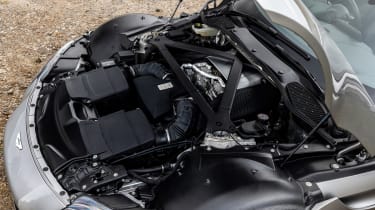Aston Martin Vantage (2018 - 2024) – engine, gearbox and tech specs
AMG-sourced V8 engine and transmission have plenty of bite and charisma
Under the Vantage’s vast clamshell bonnet is the same M177 Mercedes-AMG twin-turbo 4-litre V8 that’s also pressed into service in the DB11 and DBX SUV. As in those cars, it’s connected to an eight-speed ZF automatic transmission that’s mounted in a transaxle together with an electronically controlled limited-slip differential.
As denoted by its M177 moniker, the Vantage’s V8 is a wet-sump unit, unlike the dry-sump M178 as was used in the previous AMG GT, and largely shares its specifications with the unit found in the C63 S. There are changes, specifically around the bespoke induction and exhaust systems and the remapped ECU. Since the installation of ex-AMG boss Tobias Moers in the top job, Aston has been given the green light for more extensive changes to the powertrains, which we expect to come on stream alongside the Vantage’s wider update in 2024.
Still, the base V8’s vital statistics of 503bhp and 505lb ft of torque are hardly to be sniffed at. The latter figure is developed at just 2000rpm, hinting at some real muscle for the rear wheels to cope with, but more on that later. F1 Edition cars have a slight power bump to 527bhp thanks to a further tweak of the ECU, but torque remains the same, albeit over a wider section of the rev range.
The previously optional seven-speed manual transmission was developed from the dog-leg unit used in the previous-generation V12 Vantage S. Although it lacked finesse, it did unlock a more immersive side to the Vantage's driving experience despite a restricted 461lb ft torque figure. This was accentuated with its pairing to a completely mechanical limited-slip differential and not insubstantial 95kg weight loss – although it is worth noting that it did have an effect on front-to-rear weight balance. All-in, it’s expected that including the 200 AMR units, no more than 400 Vantage manuals ever rolled off the production line, making it a sure-fire future unicorn in the same vein as a Ferrari 599 GTB with a H-pattern between the seats.
More reviews
Under the skin the Vantage uses a shorter version of the bonded aluminium architecture first seen on the DB11. Over 70 per cent of the components used are new, with a focus on greater rigidity giving the suspension more solid foundations to work from. Also new are the subframes, which carry the multi-link rear axle and double wishbone front suspension. Roadster models don’t have an appreciable disadvantage in terms of structural rigidity, the small cabin and high scuttle helping keep the body resilient over rough roads. There are some reinforcements to the sills and underbody, but thanks to a simple and lightweight roof mechanism the Roadster’s 60kg weight gain is commendable. Overall, at 1628kg for the Roadster and 1530kg for the Coupe (both dry weights), both might seem on the chunky side, but thanks to the chassis’ inherent control and stability, plus the V8’s prodigious torque, it’s only at the very limit of adhesion that the weight becomes felt.
As with the DB11, the Vantage features extensive use of hidden aerodynamics. Despite its clean profile the Aston actually delivers genuine downforce, a feat that’s been achieved courtesy of a front splitter, vents in the front wings, a number of underbody channels and a huge rear diffuser.




